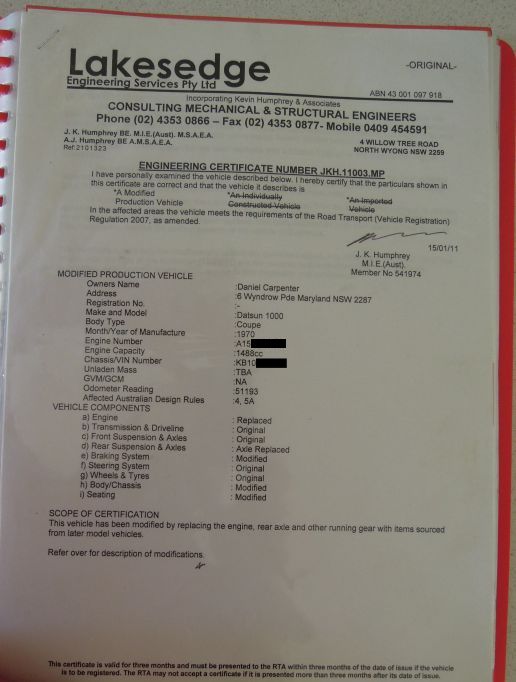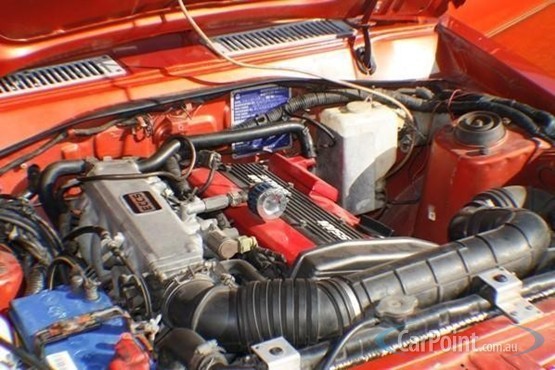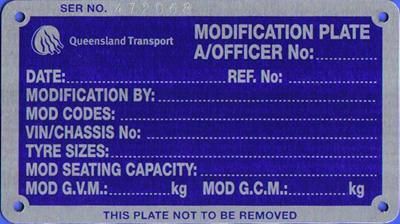Modifying a car in Australia for road use is subject to Australia Design Rules (ADR) which cover safety and emission control standards. Your car from new should have an ADR compliance plate on the firewall. When swapping engines, brakes or other major parts, an engineer will oversea the work and supply a new compliance plate (aka mod plate) to prove the changes have been approved.
Contents |
Overview
While ADR is nation-wide, each individual state has further requirements.
Run any changes by an Engineer before you start!
Additionally, aftermarket parts like lamp lenses, seat belts and glovebox doors must be approved.
Be sure *any* aftermarket parts you buy are approved!
Pay an engineer to design any modifications so that you will be sure to pass inspection.
NOTE: ADR started in 1969, which means that anything pre-1969 doesnt have to comply to ADRs. For example, it is 100% legal to have no seatbelts in a pre-1969 car.
Compliance Plate
A compliance plate certifies that the vehicle meets certain ADRs, thus is related to safety and emissions. It is not a manufacturer's plate. Even imports are given a compliance plate (usually at import time).
Web: What is a compliance plate?
This vehicle was manufactured by Nissan Motor Co. (Aust) P/L. To comply with Australian Design Rules Nos 1. 2. 3. 4. 5A. 6. 7. 8. 10B. 11. 12. 14. 15. 16. 18. 20. 21. 22. 24. 25. 26.
Datsun 1200 Sedan
8/73 67889
GVW. Lbs. Seating Cap 4
This plate is affixed with the approval of the Australian Motor Vehicle Certification Board
The Australian compliance plate affirms that the vehicle was built by Nissan to comply with Australian Design Rules. It lists all of the design rule numbers that are being complied with. ADR 27A, 27B, 27C, etc. have to do with polution controls. The more letters, the later the model it is.
The date stamped into the plate is the compliance date, which is not necessarily the same as the build month.
Certificate of Compliance
A good rule of thumb is that ADRs permit only allowed equipment. It doesn't matter if the equipment is as good as original, or even better.
- Original equipment parts without certificate of compliance are allowed.
- OEM replacement parts are allowed.
- Aftermarket parts stamped ADR approved or certificate of compliance are allowed.
E-mark
The UNECE e-marks show compliance to Automotive Directive and Regulations in most of International community. E45 indicates it meets Australia regulations, but is not an official compliance mark. Some ADRs reference ECE standards, and so parts marked accordingly will meet that particular ADR (for example, ADR 13 and lights marked E4).
ADR 18
ADR 18 concerns Instrumentation. The function of this vehicle standard is to specify requirements for the provision and location of certain visual indicators and the requirements for speedometers and odometers.
ADR 18 INSTRUMENTATION Effective date 1 Jan 1973 ADR 18a Effective date 1 Jan 1981.
Sample Checklist
- Speedometer on driver’s side and all visual indicators readily visible by the driver?
- Speed indicating element colour and background contrast?
- All essential gauges and indicators other than warning lamps provided with variable intensity illumination?
- Manufactured on or After 1 July 1988: Vehicle speed indicated in Km/h only? If NO is Major Scale Km/h?
- Speedometer readily visible to the driver?
For example, the factory original speedometer is specified. As usual, aftermarket parts with the approval mark are allowed. GPS speedometers, although very accurate, do not work in all scenarios (tunnels, etc), have a lag time and startup time.
Amendment dropped requirement for slow readings:
- indicate the actual vehicle speed, for all speeds above 40 km/h, to an accuracy of + 10 per cent.
- indicate the actual distance travelled by the vehicle to an accuracy of + 4 per cent.
North America FMVSS
FMVSS regulates automotive product in the United States. Some ADRs were originally based on FMVSS regulations, and some ADRs are equivalent to FMVSS regulations.
For example, FMVSS 201 "Head Impact Protection", formed the basis of ADR 21 when it was prepared in the late 1960s. In addition to dashboards, FMVSS 201 also covers sun visors (covered by ADR 11), seatbacks (for rear seat passengers - covered by ADR 3) and armrests (covered indirectly in ADR 42 – no dangerous projections, etc).
A problem is that parts for United States are not marked for compliance, so there is no way to confirm suitability without a certificate or e-mark.
List
ADRs affecting passenger cars manufactured before 1986
1 Reversing signal lamps Jan 1972 2 Door latches and hinges Jan 1971 3 Seat anchorages Jan 1971 3A Seat anchorages Jan 1977 4 Seatbelts Jan 1969 4A Seatbelts Jan 1974 4B Seatbelts Apr 1975 4C Seatbelts Apr 1976 4D Seatbelts Jan 1984 5A Seatbelt anchorages Jan 1969 5B Seatbelt anchorages Jan 1975 6 Direction Turn signal lamp Jan 1973 7 Hydraulic brake hoses Jan 1970 8 Safety glass Jul 1971 10A Steering columns Jan 1971 10B Steering columns Jan 1973 11 Internal sunvisors Jan 1972 12 Glare reduction Jan 1973 14 Rearview mirrors Jan 1972 15 Demisting of windscreens Jan 1971 16 Windscreen Wipers & washer Jan 1973 18 Location/visibility of ins Jan 1973 18A Location/visibility of ins Jan 1981 20 Safety rims Jul 1970 21 Instrument panels Jan 1973 22 Head restraints Jan 1972 22A Head restraints Jan 1975 23 Pneumatic car tyres Jan 1974 23A Pneumatic car tyres Jan 1984 24 Tyre selection Jan 1973 25 Anti-theft locks Jan 1972 25A Anti-theft locks Jan 1978 26 Engine emission control Jan 1972 27 Engine emission control Jan 1974 27A Engine emission control Jul 1976 27B Engine emission control Jan 1982 27C Engine emission control Jan 1983 28 Motor vehicle noise Jan 1974 28A Motor vehicle noise Jan 1981 29 Side door strength Jan 1977 31 Hydraulic brake systems Jan 1977 34 Child restraint systems Jul 1976 34A Child restraint systems Jan 1985
State Rules for Engineering
In addition, your state may implement vehicle safety rules. For example, automobile customization regulations differ between Queensland, SA and WA.
See discussion about engineering: Engineers
Maximum Engine Size
States generally use the NCOP guidelines, which limit engines to 2-liter, non-turbo in a car as light as the Datsun 1200.
So how do people register larger engines?
sssute:I get asked this question on a daily basis.
It can be done in any state, it just finding the engineer that knows what they are doing. All states follow the same ADR rules, so state to state makes no difference. If you just roll up to the Motor reg. department and ask they will say NO, that because they are going by the documents from the guidelines to modifying a Vehicle. These are a Guideline not the rule book. If you engineer can prove with evidence that you car out performs all the required ADR's they can not so no. We have been doing this for years in Adelaide with a few different very good engineers. Its not cheap, so dont think you can get it done for $500 or $1000, they normally charge $2500 upwards, depending on what you are doing. My engineer has said to me, that using a lot of my products and my fabrication, we can get a twin turbo LS regoed. And before you say it (my states rego department is the hardest to deal with) not true. It finding the engineer is the hard thing.
New South Wales
Refer to RTA document VSI 06 "Light Vehicle Modifications" from the RTA (NSW Roads and Traffic Authority, aka the registration authority) web site.
http://www.rta.nsw.gov.au
Maximum engine size normally allowed (engineer certified) is related to the official listed weight of the vehicle (not by your measurement). For a Datsun 1200 in NSW a maximum size is allowed reportedly:
- 2190cc engine (naturally aspirated)
- 1825cc forced induction (supercharged or turbocharged)
- 12A Rotary (13B is too large)
Engine changes where the capacity is less than 15% above the maximum engine size available for the vehicle ...
Since the maximum engine size for a Datsun 1200 was 1171cc, you can then owner certify up to 1171cc + 15% = 1346 cc. So fitting an A13 can be owner certified, but an A14 is too big.
Above that will take engineer certification.
What is the maximum size engine for engineer certification?Maximum engine capacity
Normally aspirated: Original tare mass (kg) x 3.0
Supercharged or turbocharged: Original rate mass (kg) x 2.5
'Original weight' is the original (unmodified) 'tare weight' of the sedan version of the vehicle...
Vehicles with engines of greater capacity than that provided in the table will not be acceptable for registration as a modified production vehicle.
fm1200 said "This weight is 730kg" for sedan/coupe ISL33P said "RTA ... have the ute at a tare weight of 690kg"
For a rotary engine, a 12A will meet the rule, but not a 13B.
Any engine larger will require Individually Constructed Vehicle certification. This generally involves adding a frame, or widening the chassis, or modifying the engine layout (e.g. mid-engine setback or rear-engine), or "significant" change to the unibody. This is how large engines like the SR20DET are allowed.
Queensland
Minor Modifications
Many minor modifications can be carried out without obtaining written approval. For example, installation of an accessory (e.g. long range aerial, tow bars, roof racks etc).
Basic modifications
Basic modifications do no require formal approval from an Approved Person or the Department of Transport and Main Roads. But any person performing a basic modification must ensure they meet all the requirements listed in the NCOP, and any applicable requirements of the Australian Design Rules and the vehicle standards.
- Fitting a replacement new, used or reconditioned engine
- Fitting equivalent engines with an increase of up to 20% of original power.
Modifications under COP
Complex modifications such as engine upgrades, gearbox and rear axle changes, vehicle body modifications and steering and brake replacements ... VSI L20.0 – Engine modifications under the National Code of Practice for Light Vehicle Construction and Modification
reference: TMR Queensland
National Code of Practice
download PDF - NCOP Engine section
- Fitting engines greater than 120% of original power and/or engine mass
- Fitting performance engines
- Fitting engines from non original equipment sources
- Installing a supercharger or turbocharger
ENGINE CAPACITY
All vehicles originally weighing less than 800 kg: Original mass (kg) x 3.0 = max. capacity in CCs. Turbo/Supercharged: Original mass (kg) x 2.5.
The maximum engine capacity for rotary engines is calculated by multiplying the swept volume of all rotors by two (e.g. a 13B rotary engine has a swept volume of 1308 cc resulting in a calculated maximum capacity of 2616cc).
So basically the same as the long-used NSW engine displacement rules.
The power and/or torque of the replacement engine should not exceed the capacity of the vehicle driveline.
Emission Controls
- ADR 27/27A requires the first batch of controls starting in 1973
- ADR 37 requires the catalytic convertor
When transplanting engines, refer to vsi06: http://www.shoeys.com/docs/vsi06.pdf
Emission standards for replacement engines
1972 and later model vehicles with substitute engines must meet the intent of the later of the Australian
Rules applicable to either:
a) the original vehicle; or
b) the substitute engine
<p>To ensure continued compliance with emission standards, any replacement engine should come from which is subject to the same or more stringent emission control requirements. An alternative is for an earlier to be upgraded during reconditioning to more recent engine specifications. All anti-pollution devices should be fitted and functional. Vehicles manufactured prior to noise and/or exhaust emissions related ADRs must meet certain minimum and emission requirements if the engine modification is to such an extent as to require certification by an engineering signatory. Engineering signatories will be able to give you more information about these requirements.

![[Datsun 1200 encyclopedia]](/wiki/upload/wiki.png)





